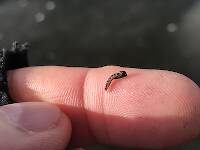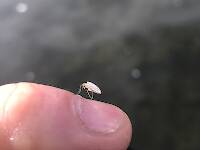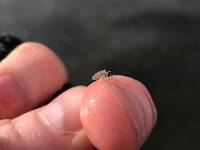
Salmonflies
Pteronarcys californica
The giant Salmonflies of the Western mountains are legendary for their proclivity to elicit consistent dry-fly action and ferocious strikes.
Featured on the forum

This specimen keys pretty easily to Onocosmoecus, and it closely resembles a specimen from Alaska which caddis expert Dave Ruiter recognized as this genus. As with that specimen, the only species in the genus documented in this area is Onocosmoecus unicolor, but Dave suggested for that specimen that there might be multiple not-yet-distinguished species under the unicolor umbrella and it would be best to stick with the genus-level ID. I'm doing the same for this one.

Troutnut is a project started in 2003 by salmonid ecologist Jason "Troutnut" Neuswanger to help anglers and
fly tyers unabashedly embrace the entomological side of the sport. Learn more about Troutnut or
support the project for an enhanced experience here.
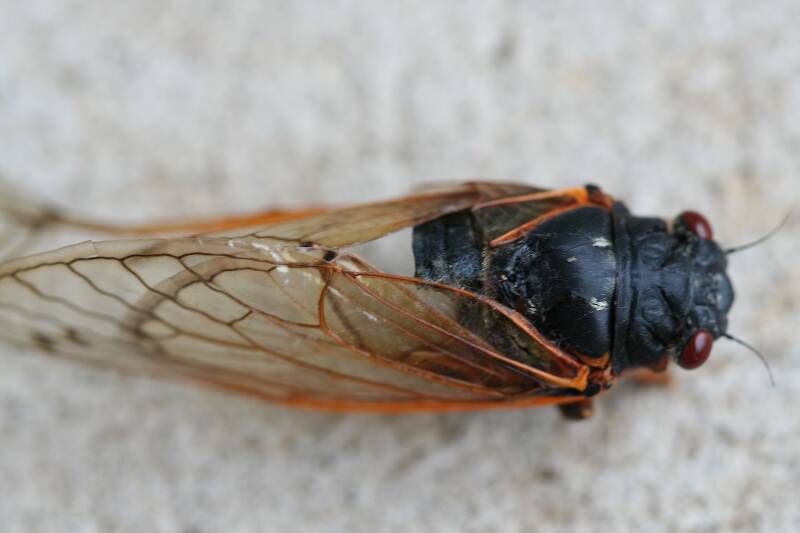
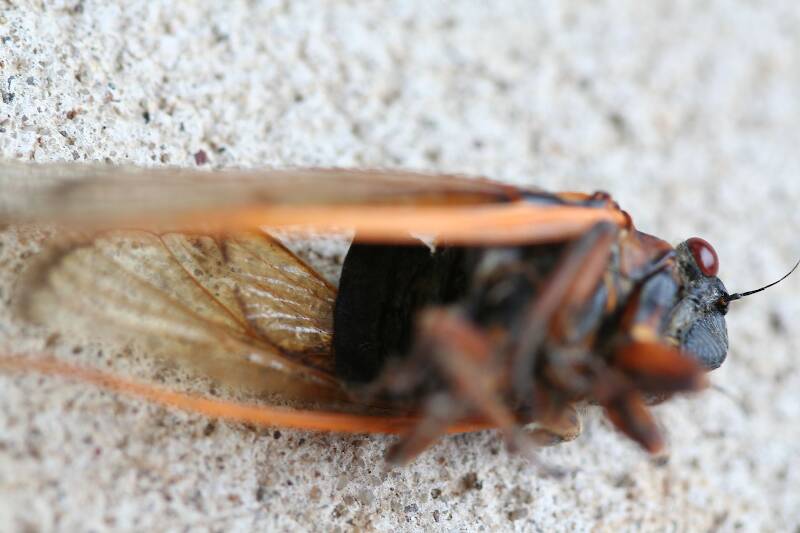
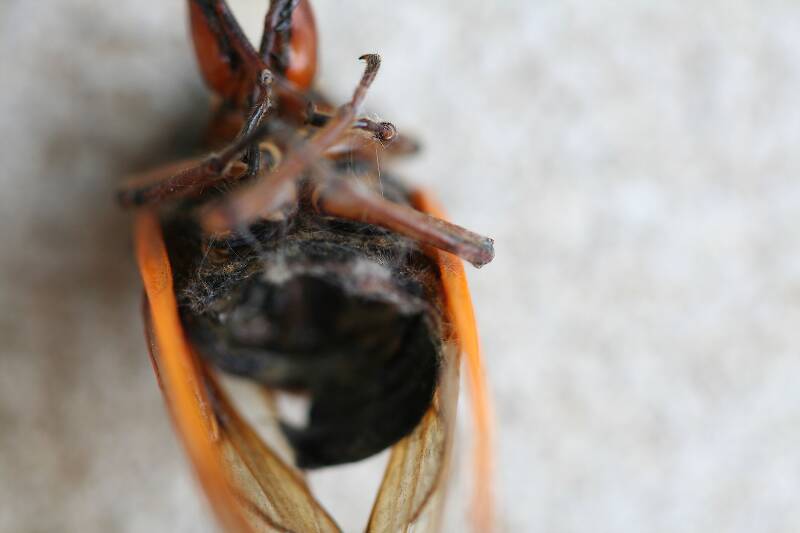
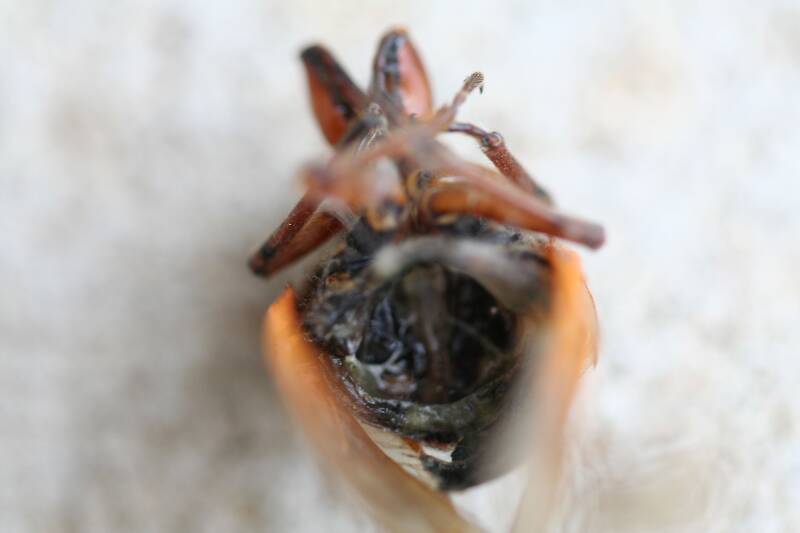
Shawnny3 on Jun 28, 2008June 28th, 2008, 4:01 am EDT
I found this specimen on the cover of my grill. At first I noticed one of its wings was partially torn off, and then it dawned on me that its body was shorter than normal. I looked at it closer and noticed that more than half its body was missing. Further inspection showed that the inside of the remaining shell was hollowed out the entire way to the thorax. Now, I know that cicadas are wonderful food for birds and such, and I've seen many parts of them lying around lately, but there was something that shocked me about this particular specimen - it was still alive. In fact, it was crawling around as though it were totally unaware that more than half of its body was gone. It was using only its front four legs (its last set of legs and its wings limp), but it was fully alert and walking around. I kept it alive for an hour in a jar until I finally put it in the freezer to kill it and get pictures.
Maybe this is the sort of thing you entomologists out there see all the time, but I had never seen anything like it and found it quite fascinating.
-Shawn
Maybe this is the sort of thing you entomologists out there see all the time, but I had never seen anything like it and found it quite fascinating.
-Shawn
Jewelry-Quality Artistic Salmon Flies, by Shawn Davis
www.davisflydesigns.com
www.davisflydesigns.com
Shawnny3 on Jun 28, 2008June 28th, 2008, 5:26 am EDT
I just went outside with my son and he found another cicada in the same state - no abdomen, walking around on its front four legs. So maybe this isn't such a rarity. But still pretty cool to watch.
-Shawn
-Shawn
Jewelry-Quality Artistic Salmon Flies, by Shawn Davis
www.davisflydesigns.com
www.davisflydesigns.com
LittleJ on Jun 28, 2008June 28th, 2008, 3:18 pm EDT
i'm gonna miss those ugly things!
Jjlyon01 on Jun 29, 2008June 29th, 2008, 5:09 am EDT
We got plenty down in Texas. Does anyone know if they hatch annually in some parts of the country (such as Texas) and only every 7 years in others (such as New York)?
"I now walk into the wild"
GONZO on Jun 29, 2008June 29th, 2008, 2:28 pm EDT
Hi Jamie,
Some cicadas are "annual" and some are "periodic" (17-year and 13-year). The periodic cicadas are divided into different broods designated by roman numerals. Different broods hatch at different times and in different locations. Some broods are rather small and others are massive. For example, brood "X" of the 17-yr. is the really big one (also known as the Great Eastern Brood) that hatched in 2004, 1987, and 1970. If I'm not mistaken, the one that Shawn is seeing is brood "XIV" (which would have last appeared in 1991). I believe you have the 13-yr. variety in parts of Texas (the 17-yr. is more northern), as well as annuals.
Some cicadas are "annual" and some are "periodic" (17-year and 13-year). The periodic cicadas are divided into different broods designated by roman numerals. Different broods hatch at different times and in different locations. Some broods are rather small and others are massive. For example, brood "X" of the 17-yr. is the really big one (also known as the Great Eastern Brood) that hatched in 2004, 1987, and 1970. If I'm not mistaken, the one that Shawn is seeing is brood "XIV" (which would have last appeared in 1991). I believe you have the 13-yr. variety in parts of Texas (the 17-yr. is more northern), as well as annuals.
Jjlyon01 on Jun 30, 2008June 30th, 2008, 10:53 am EDT
Thanks Gonzo,
I was wondering if there might have been multiple hatches. Its really amazing how their brood cycles take so long and they only come above ground for such a short span of time. I wish I were able to get into the hatch up in New York this year, but the bass down here enjoy them as well.
I was wondering if there might have been multiple hatches. Its really amazing how their brood cycles take so long and they only come above ground for such a short span of time. I wish I were able to get into the hatch up in New York this year, but the bass down here enjoy them as well.
"I now walk into the wild"
Martinlf on Jun 30, 2008June 30th, 2008, 12:21 pm EDT
Jeff, I'm with you, buddy. Shawn, I hope you've been taking advantage of this hatch. There's still time. Take a look at
http://www.cicadamania.com/cicadas/
for more info. on cicadas.
http://www.cicadamania.com/cicadas/
for more info. on cicadas.
"He spread them a yard and a half. 'And every one that got away is this big.'"
--Fred Chappell
--Fred Chappell
BGrnFlyfish on Jun 30, 2008June 30th, 2008, 3:27 pm EDT
Last summer wisconsin had their hatch of cicadas wich was last done in 17 years. I did not get to fish but I was told they were everywhere and the fish were hammering them!!
Seth-Big Green River, WI
GONZO on Jun 30, 2008June 30th, 2008, 6:35 pm EDT
OK, I still want to know what's happening to Shawn's cicadas. Is there some kind of weird little cicada-sucking chupacabra loose in Happy Valley? 8-{
Taxon on Jun 30, 2008June 30th, 2008, 11:07 pm EDT
Gonzo-
Dragonflies are known to selectively feed on the part of a prey insect which the find tasty, and to discard the remainder, which then falls to the ground. This is simply speculation, but perhaps they have a fondness for cicada abdomen.
Dragonflies are known to selectively feed on the part of a prey insect which the find tasty, and to discard the remainder, which then falls to the ground. This is simply speculation, but perhaps they have a fondness for cicada abdomen.
Martinlf on Jul 1, 2008July 1st, 2008, 3:18 am EDT
Perhaps, Roger, but given the size of the cicadas I'd assume it would take a very large dragonfly to accomplish this feat. Might it be birds too small to eat the whole bug pecking away the more appetizing section? At a campground where I stayed last weekend, we saw a dove too full of cicadas to move off the road (we had to swing around it to keep from hitting it), and a robin that couldn't get airborne after feasting. The fish are hammering the bugs too, as Jeff indicates. I was taught by a cicada guru to fish the water, putting the imitation withing inches of the bank in shaded or other holding areas. Strikes were explosive. 1X tippet was helpful to avoid break offs.
"He spread them a yard and a half. 'And every one that got away is this big.'"
--Fred Chappell
--Fred Chappell
Shawnny3 on Jul 1, 2008July 1st, 2008, 4:37 am EDT
I was inclined to think what Louis did, but I really don't know for sure. Some violence was definitely done to the bug, though - this was not some genetic anomaly. Perhaps I just have a particularly sadistic bird roaming my back yard. I'm going to start keeping an eye on them...
-Shawn
P.S. By the way, Louis, hope you're enjoying your summer (I can say that now that I'm on break as well - before that it was too painful). If it didn't cost $100 in gas to make a trip to the Little J. (OK, that might be a slight exaggeration), I'd say we should meet up down there for a day of fishing.
-Shawn
P.S. By the way, Louis, hope you're enjoying your summer (I can say that now that I'm on break as well - before that it was too painful). If it didn't cost $100 in gas to make a trip to the Little J. (OK, that might be a slight exaggeration), I'd say we should meet up down there for a day of fishing.
Jewelry-Quality Artistic Salmon Flies, by Shawn Davis
www.davisflydesigns.com
www.davisflydesigns.com
CaseyP on Jul 1, 2008July 1st, 2008, 6:53 am EDT
If it didn't cost $100 in gas to make a trip to the Little J. (OK, that might be a slight exaggeration), I'd say we should meet up down there for a day of fishing.--Shawn
three good black foam cicada imitations with deer-hair and pearl flashabou wings, big orange eyes, and an orange indicator on its thorax: $6.00
A 1x or other very strong leader: $3.00
gas to get to the Little J: $100
catching a usually very shy very big trout in the daytime by simply aiming at the bank with NO CLUE whether or not there is a fish over there, and knowing that this is a once-in-17-years opportunity: PRICELESS, DUDE!
so when and where, guys?
"You can observe a lot by watching." Yogi Berra
GONZO on Jul 1, 2008July 1st, 2008, 7:04 am EDT
Roger, Louis, and Shawn:
Both the bird and dragonfly hypotheses sound quite reasonable. After seeing a dragonfly drag most of the belly of a buddy's 5 wgt. fly line into the air years ago, I'd be the last to underestimate their lifting power.
However, not being one to give up on a pet theory easily, I'm still partial to the cicada-sucking chupacabra (chupacicada?) hypothesis. I further hypothesize that these little demons might be hitchhiking on the hairy backs of wandering sasquatch, which are believed to be slowly making their way east from their ancestral home in the Pacific Northwest. I think the sasquatch are probably looking for better jobs, having abandoned their former employ in the logging industry. Perhaps they have come to Happy Valley seeking higher education and hoping to conceal themselves among the ranks of scrufty PSU undergrads. Just a thought....
(Actually, I'm just trying to give Shawn nightmares. If he's starting to worry about his backyard birds, he's probably the suggestible type.) :)
PS--Go for it, Casey! The situation that you (and Louis) describe is the stuff that cicada dreams--and memories--are made of. (As opposed to the kind of cicada dreams that I have attempted to inspire in Shawn.)
Both the bird and dragonfly hypotheses sound quite reasonable. After seeing a dragonfly drag most of the belly of a buddy's 5 wgt. fly line into the air years ago, I'd be the last to underestimate their lifting power.
However, not being one to give up on a pet theory easily, I'm still partial to the cicada-sucking chupacabra (chupacicada?) hypothesis. I further hypothesize that these little demons might be hitchhiking on the hairy backs of wandering sasquatch, which are believed to be slowly making their way east from their ancestral home in the Pacific Northwest. I think the sasquatch are probably looking for better jobs, having abandoned their former employ in the logging industry. Perhaps they have come to Happy Valley seeking higher education and hoping to conceal themselves among the ranks of scrufty PSU undergrads. Just a thought....
(Actually, I'm just trying to give Shawn nightmares. If he's starting to worry about his backyard birds, he's probably the suggestible type.) :)
PS--Go for it, Casey! The situation that you (and Louis) describe is the stuff that cicada dreams--and memories--are made of. (As opposed to the kind of cicada dreams that I have attempted to inspire in Shawn.)
CaseyP on Jul 1, 2008July 1st, 2008, 9:40 am EDT
PS--brood X produced these unfortunate critters as well, in our driveway, and we just assumed that robins or crows or other birds that pick up and shake bigger things into smaller bites had been dining in the vicinity...
yeah, it's really weird to speculate just what is necessary for "life" to continue.
yeah, it's really weird to speculate just what is necessary for "life" to continue.
"You can observe a lot by watching." Yogi Berra
GONZO on Jul 1, 2008July 1st, 2008, 10:24 am EDT
Aha! The plot thickens and anecdotal evidence for my minority hypothesis grows. Casey, some of the migrating sasquatch are believed to have made their way across the country by the southern route, leading to sightings of "Skunk Apes" or "Stink Apes" in places like Arkansas, Oklahoma, Florida, and North Carolina. (Being the cautious, fretful, and suspicious type, I follow such things carefully.)
Perhaps the northernmost of this wandering band of hairy hominid cryptids made their way into your area during the last emergence of brood "X" in 2004. And perhaps that is when and where they picked up their "chupacicada" hitchhikers. Further, it seems reasonable to speculate that the same band has now, four years later, moved on a northward trajectory into the State College area, their demonic little cicada-sucking associates guiding them (through hypnotic suggestion or ESP, I assume) to follow the emergence of the various cicada broods.
Kinda makes you second-guess the bird and dragonfly theories, doesn't it??!! Such pedestrian and seemingly reasonable theories are often espoused by people working with the "men in black" in order to ward off mass panic, and I now believe that Roger and Louis are actually in cahoots with the same people who claimed that the Roswell Incident was just a weather balloon.
Shawn, are you scared yet?
Perhaps the northernmost of this wandering band of hairy hominid cryptids made their way into your area during the last emergence of brood "X" in 2004. And perhaps that is when and where they picked up their "chupacicada" hitchhikers. Further, it seems reasonable to speculate that the same band has now, four years later, moved on a northward trajectory into the State College area, their demonic little cicada-sucking associates guiding them (through hypnotic suggestion or ESP, I assume) to follow the emergence of the various cicada broods.
Kinda makes you second-guess the bird and dragonfly theories, doesn't it??!! Such pedestrian and seemingly reasonable theories are often espoused by people working with the "men in black" in order to ward off mass panic, and I now believe that Roger and Louis are actually in cahoots with the same people who claimed that the Roswell Incident was just a weather balloon.
Shawn, are you scared yet?
Shawnny3 on Jul 1, 2008July 1st, 2008, 11:27 am EDT
Yes, Lloyd, you are scaring me, though not in the way you intended...
-Shawn
-Shawn
Jewelry-Quality Artistic Salmon Flies, by Shawn Davis
www.davisflydesigns.com
www.davisflydesigns.com
CaseyP on Jul 1, 2008July 1st, 2008, 3:31 pm EDT
hey--you guys read the dobson fly thread? are dobson flies insectiverous? (or whatever?) sounds like they'd be big enough!
Gonzo, ride the Metro sometime. Men In Black was not fiction...
Gonzo, ride the Metro sometime. Men In Black was not fiction...
"You can observe a lot by watching." Yogi Berra
Wyflyfish on Jul 1, 2008July 1st, 2008, 3:43 pm EDT
Wyoming's 17 yr. hatch was last summer.... It was one for the ages. Fishing was lights out, and nearly every fish that ate our imitations were better than average browns. I am seeing ciccadas out this summer, but not in near the numbers (I am assuming these are the annuals, although I am not as familiar with the bug). Our bugs here seem to have more of a yellow underbody and stripe on the leg than the orange on the ones pictured. We used big Fat Alberts with Yellow and Black segmented legs to immitate them. Any other suggestions?
wyflyfish
GONZO on Jul 1, 2008July 1st, 2008, 4:26 pm EDT
...you are scaring me, though not in the way you intended...
Are you sure about that, Shawn?
...ride the Metro sometime. Men In Black was not fiction...
Who said it was?
C'mon, guys. If you refuse to play along when I try to have a little fun, I'll be forced to go back to droning on about aquatic insect identification and such. Is that really what you want? (Think long and hard before answering.)
Instead, I think it would be much more fun if Shawn and Casey would claim to have seen a horrible little beast that chortled wickedly as it sucked the guts out of one hapless cicada after another, only to leave the poor insects limping along on their front legs as the life drained from their ravaged bodies. They could add that the little monsters had glowing red eyes and...oh yeah, an incredibly foul stench. (That would develop the "Skunk Ape" connection.)
Who knows, maybe we could even get one of those malcontents who get their jollies by rewriting the Wikipedia pages to include the "chupacicada" (definition: cicada sucker) in the Cryptozoology listing.
Now that, my friends, would be truly scary!
Quick Reply
Related Discussions
Topic
Replies
Last Reply
Re: The last few days of winter are over... spring steelhead and browns get hot! 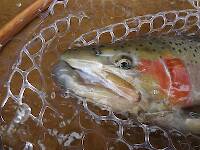

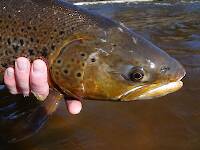
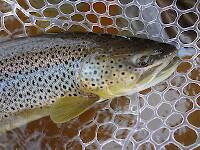
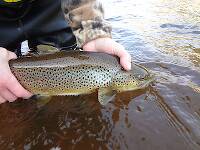
In the Photography Board by Pryal74
+ 7





In the Photography Board by Pryal74
11
Mar 16, 2012
by Pryal74
by Pryal74
6
Jan 12, 2012
by Jmd123
by Jmd123
2
Mar 21, 2007
by CalebBoyle
by CalebBoyle





